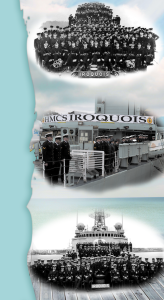Iroquois pays off
By Lookout on May 11, 2015 with Comments 0

The crew of the first HMCS Iroquois, commissioned in 1942, crowd the deck of the ship.
The Naval Ensign has been lowered for the last time in HMCS Iroquois.
The Royal Canadian Navy (RCN) honoured the Tribal class destroyer for its 43 years of service with a paying off ceremony at HMC Dockyard Atlantic, May 1.
Commissioned on July 29, 1972, the anti-submarine warfare destroyer served as the command ship of the East Coast Fleet.
Iroquois was the first of its class, one of four RCN destroyers.
Iroquois completed a Tribal Class Update and Modernization Project refit in 1992, when it was made a modern area air defence platform.
VAdm Mark Norman, Commander RCN, said for those on the outside, a ship is just a lot of steel.
“Those of us who go down to the sea in ships see it differently. We see it as a living thing, brought to life by the passion, energy and professionalism of the crew.”
He said one synonym for a vessel is a container – “a container of unbridled enthusiasm.”
He shared one memory from his own time in Iroquois, running the main passageways of the ship playing peek-a-boo with his then four-year-old daughter, upon return from a long deployment.
To the ship’s company past and present, as well as the trades people of Fleet Maintenance Facility Cape Scott, VAdm Norman said, “I thank you for keeping the old girl running. It is truly time to thank her and say farewell.”
He spoke of transition, turning tides, and moving forward.
“It’s time to close a chapter. It’s time to say goodbye.”
RAdm John Newton, Commander Maritime Forces Atlantic, told stories from many Iroquois missions, such as fighting through 70-foot seas while en route to Iceland at the height of the Cold War, thereby testing the kit required by a warship to serve in the North Atlantic.
“She has taught a whole generation about the modern warfare threat environment and what Canada must concern itself with to protect national interest in a confused and unsettled world,” said RAdm Newton.
This was the second RCN ship to be christened HMCS Iroquois.
The predecessor was a Second World War fighting ship.
Present in the audience were both LS (Ret’d) Doug Ivany and CPO2 (Ret’d) Graham MacBride, two final company members of the original Iroquois that commissioned in 1942.
They fought in the Korean War, during which Iroquois experienced the only three casualties of that conflict for Canada’s navy on Oct. 2, 1952.
Cdr Rob Watt, final commanding officer of Iroquois said, “The Canadian Navy is just over 100 years old. For over half that time there has been an HMCS Iroquois.”
More than 11,500 men and women have served in Iroquois. For those sailors, said Cdr Watt, the ship is more than a weapons platform – it is their home.
“I’ve been humbled by the opportunity to lead Iroquois, and I speak for the crew when I say it’s been an honour to serve in the final ship’s company.”
He closed with the ship’s motto – “Relentless in chase, Iroquois.”
A Sea King saluted the ship with a helicopter fly past, as the 380-foot decommissioning pennant was ceremoniously passed along the deck and down to the jetty.
The ship’s company gave their final cheers before marching down the gangway.
One of Iroquois’ well-remembered missions was on Dec. 4, 1983, when the crew received an SOS from the Ho Ming 5 while patrolling the fishery on the Grand Banks.
The Panama freighter was listing badly and in danger of capsizing due to shifting cargo.
VAdm (Ret’d) Larry Murray was Commanding Officer at the time, and in attendance at the paying off ceremony.
The ship and the air detachment saved 21 lives in hurricane conditions. Eighteen members of the ship’s company received decorations for that rescue.
He said of seeing the ship paid off, “It’s quite nostalgic actually. It’s kind of the end of an era.”
As for other sailing stories, he said, “The anecdotes are the people you sailed with.”
He said a bond will remain among sailors who sailed in Iroquois, partly driven by the history of the first Iroquois, renowned in the Second World War.
“To have an opportunity to sail in the second Tribal Class was pretty special.”
Iroquois served with the blockading force off the former Yugoslavia in 1993 and 1994, was made flagship of Maritime Operations Group 1 in 1995 and later flagship of NATO Standing Naval Force Atlantic in 1998.
In 2000, crew and ship rescued 13 sailors and six bodies from an accident off Bermuda.
In 2001, it joined a U.S.-led coalition against international terrorism in the Arabian Sea.
Iroquois then continued work in the Arabian Sea, deploying three times as flagship of the multi-national Task Force 150.
In the final years of service the ship made two representational voyages: to Baltimore in 2012 for the bicentennial of the War of 1812, and to Liverpool in May of 2013 for the anniversary of the Battle of the Atlantic.
On this particular voyage, the crew met Rosemary Thompson, who has since been named honorary Grandmother of Iroquois.
She was married to Royal Navy signalman George Thompson, who sailed with HMS Vidette in the Battle of the Atlantic.
Thompson travelled from Shrewsbury, England, to attend the paying off ceremony.
While the ceremony took place, 114 past and present members of the Iroquois were deployed on Operation Caribbe in sister ship Athabaskan.
Beth Brown
Trident
Filed Under: Top Stories
About the Author:





